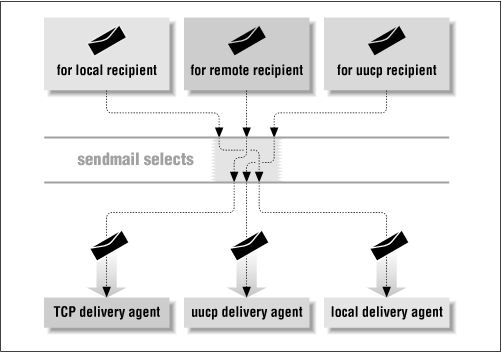 | Chapter 6 The Mail Hub and Delivery Agents |  |
Other than forwarding mail messages over a TCP/IP network, sendmail does not handle mail delivery itself. Instead, it runs other programs that perform delivery (see Figure 6.2). The programs it runs are called delivery agents. Information about which agent performs which kind of delivery is defined in the sendmail.cf file.

The first item to put in your client.cf file is a definition of the program (delivery agent) that forwards mail to the hub machine. That definition provides sendmail with the information it needs to deliver mail using that delivery agent. Initially, sendmail needs to include only the name and location of that program. Therefore, in its preliminary form, the definition for the mail delivery program looks like this:
# This is a comment V7 # this is another comment# Delivery agent definition to forward mail to hubnew
Mhub, P=[IPC], A=IPC $hnew
This is a minimal (and still useless) configuration file. Go ahead and add these new lines to client.cf. The second line is a configuration command that defines a delivery agent. It contains three parts, each separated from the others by commas: a symbolic name and two equates.
Mhub The M that begins the line defines a mail delivery agent.
The hub immediately following is the symbolic
name for the delivery agent. This symbolic name will be
referenced by other parts of the
configuration file when you write them.
P=[IPC] The P= equate stands for Path. This says that the full
pathname of the program that is used
to handle the delivery is called [IPC].
([IPC] is a special name used internally by sendmail
to represent its internal ability to communicate over TCP/IP networks.
It stands for interprocessor communications).
For other mail
delivery agent definitions the name following the =
would be the full pathname of a program, such as /bin/mail.
A=IPC $hThe A= equate stands for Argument vector (list). It is used
to specify the command-line arguments that will be given
to the P= program when it is run. The zeroth argument
is the name of the program (here IPC without brackets).
The rest of the arguments, of which there is only one here, the $h,
are the actual
command-line arguments. The $h is a macro that contains
the recipient's hostname. We'll describe macros in the next chapter.
The A= equate is traditionally the last item in a delivery
agent definition.
Run sendmail with this command line:
%/usr/lib/sendmail -oQ/tmp -Cclient.cf -bp
Note that you need to include -oQ/tmp in the
command line to
prevent sendmail from
trying to change to the mqueue directory
(which probably doesn't exist under the current directory).
If you leave out the -oQ/tmp switch, sendmail
exits with this confusing error:
cannot chdir((null)): Bad file number
The -Cclient.cf switch tells sendmail to use the file
client.cf in the current directory as its configuration
file, rather than the system /etc/sendmail.cf file.
The -bp switch tells sendmail to print the contents of the
queue.
The above command line should produce output like the following:
No local mailer defined
The lack of a local
mailer is not important yet.
[4]
The sendmail program
prints it and stops but otherwise found no errors in our client.cf file.
[4] A
localdelivery agent is not required in rule-testing mode (-bt) but is required for all other modes.